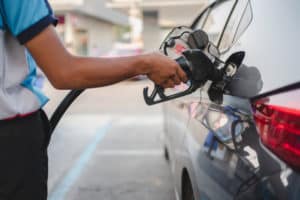
As you’ve likely noticed, gasoline prices have hit a national all-time high. Fortunately, there are ways to cope with this grim milestone. Whether you’re driving a newer model or getting your money’s worth from an old reliable ride, there are tons of ways to go further on a gallon of gas.
Some drivers believe that fuel economy is a fixed number, similar to cargo space. However, the reality is that your driving habits and how often you bring your vehicle in for routine maintenance all can impact how much you’re paying at the pump. Similarly, following these practices can help you avoid any costly repairs in the future.
If you’re looking to get the most out of your vehicle, try these 5 ways to get better gas mileage:
1) Follow routine maintenance
A little TLC goes a long way when it comes to fuel economy. Bringing your vehicle into a dealership for routine maintenance can help identify any areas where your car is not performing optimally. According to the U.S. Department of Energy, drivers can improve their fuel efficiency by roughly 10 percent by keeping their vehicles properly serviced. When you consider that Americans are spending nearly $5,000 a year on gasoline now, that can be up to $500 in savings!
There are a few components that are essential to your car’s mileage. One that has the largest impact is your car’s oxygen sensor. In some cases, an improperly-working oxygen sensor can decrease your gas mileage by as much as 40 percent.
It may be tempting to delay a trip to the service department, but the money you’ll save in the long run is well worth the visit.
2) Keep your tires properly inflated
Small maintenance tips can add up and go a long way in improving your gas mileage. It’s estimated that 1.25 billion gallons of gas are wasted each year on underinflated tires. That’s approximately 1% of total gas consumption!
Underinflated tires burn through gas quicker, and they’re dangerous, too. The reason for this is that low tire pressure causes your vehicle to drag, thus burning fuel easier. One study by the National Highway Traffic Safety Administration (NHTSA) revealed that every 1% decrease in tire pressure correlated to a 0.3% reduction in fuel economy.
When Edmunds.com put this to the test by studying their employees, they found that on average, their employees (all automotive enthusiasts to begin with) had underinflated tires of about 2.24 “pound per square inch” or PSI.
Under normal circumstances, a tire’s inflation pressure will decrease by 1 to 2 PSI every month. This means if you aren’t adding air back into your tires every month to two months, you’re burning excess fuel.
Needless to say, if it’s been a while since you last checked your tire pressure, be sure to do that soon. It’s important not only for saving gas but also for improved safety and the prevention of tire wear, which could save you even more money. Fortunately, this is a simple fix and can be done at nearly any gas station. Be sure to check your owner’s manual for your vehicle’s specific PSI ratings beforehand.
3) Check the alignment
Have you noticed vibration in your steering wheel, uneven tire wear, or your car pulling to one side? If so, it’s time for an alignment check. Misaligned tires drag, meaning they burn more fuel. It’s estimated that improper alignment can reduce gas mileage by as much as 10 percent – roughly 31 cents per gallon. Similarly, improper alignment causes your tires to wear out quicker, meaning you’ll need to replace them sooner.
Tires should be balanced and rotated according to your vehicle’s owner’s manual. Time to get yours inspected? Stop in our Express Service Lane for speedy, expert service – no appointment needed!
4) Avoid excessive idling
Idling is a major fuel waster and burns several billion gallons of gas per year, according to the Department of Energy.
Today, newer models feature a Stop/Start Engine, which turns off the engine while you’re waiting at red lights, for instance. The reason for this is to help save on fuel. Waiting at a red light can take upwards of 2 to 3 minutes while starting your car only requires 10 seconds of gas.
If you have to stay in your car for longer than a minute and you are parked safely, it is highly recommended to stop your vehicle. Newer cars are equipped with heavy-duty starters that can handle dozens of starts a day, but it should be noted that turning your engine on and off excessively can increase starter wear in older models.
5) Adopt good driving habits
Kindness on the road pays off. Aggressive driving habits like speeding and gunning the engine burns through fuel rapidly.
Practicing good driving habits isn’t just the safe thing to do, but it can also save you money. The Department of Energy states that for every 5 mph you drive over 50 mph, “you are paying an additional $0.18 per gallon.”
In real-world testing by Edmunds.com, they found that aggressive driving, such as rapid acceleration and sharp braking, was the biggest culprit for reduced fuel economy. Furthermore, they found that drivers who adopted good driving habits could save 33 percent to 38 percent on gas.
Tired of your gas-guzzling vehicle? Trade it in for a newer model! We have dozens of options available now at United Nissan Imperial, from award-winning, fuel-efficient models to gas-saving hybrids. Value your trade using our online tool.
Or, if you’re tired of gas altogether – go electric. United Nissan Imperial in Imperial, CA has various all-electric options for drivers. Shop our new Nissan models and used car lot online or visit us in-store at 2361 CA-86.



